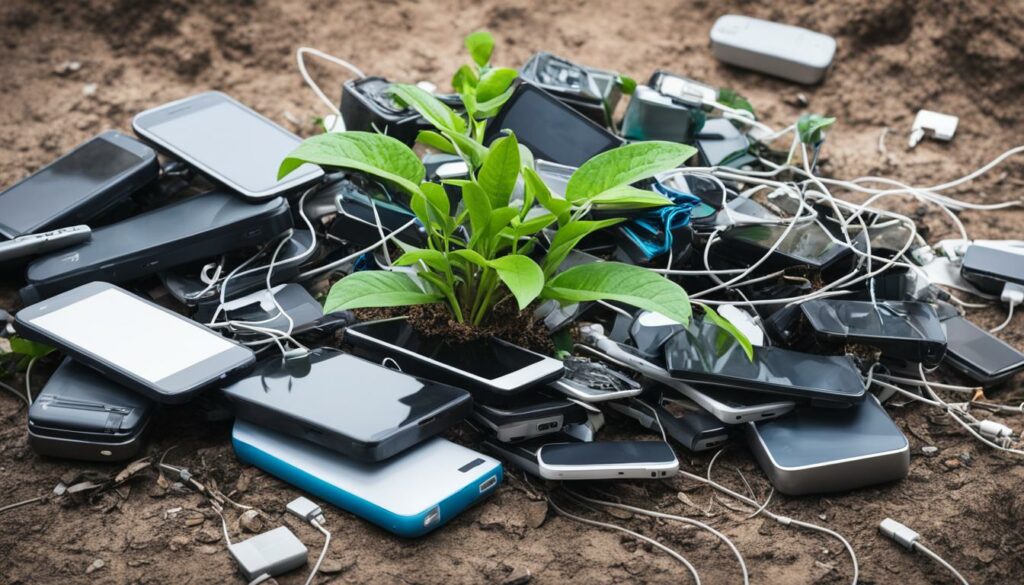Have you ever wondered how much tech trash is needed to produce a laptop? As the world becomes increasingly reliant on technology, the disposal and recycling of electronic waste have become paramount. Proper e-waste management not only reduces environmental and health risks but also promotes a more sustainable future. In this article, we will explore the quantities of tech trash required for laptop production, the importance of recycling electronics, and strategies to reduce e-waste.
Key Takeaways:
- Electronic waste is a global concern, with 44.7 million metric tons generated in 2016.
- The United States Environmental Protection Agency estimates that e-waste is growing two to three times faster than any other waste stream.
- Proper disposal and recycling of e-waste are crucial to reduce environmental and health risks.
- Recycling electronic waste not only protects the environment but also brings financial benefits.
- Both consumers and manufacturers play important roles in reducing technological waste.
What is Tech Trash and How to Obtain It in Rust
In the popular game Rust, Tech Trash is a valuable collection of random tech parts that players can use to create multi-tiered items. Obtaining Tech Trash is an essential aspect of advancing in the game and unlocking powerful gear.
There are several methods for obtaining Tech Trash in Rust:
- Looting Crates: Exploring the game world and searching for crates can yield Tech Trash as a reward. Crates can be found in various locations, such as abandoned buildings or monuments.
- Recycling a Targeting Computer: Disassembling a targeting computer will provide players with a certain amount of Tech Trash. This method is useful for players who have obtained a targeting computer through looting or crafting.
- Recycling a CCTV Camera: Similar to the targeting computer, recycling a CCTV camera can also yield Tech Trash. This method requires players to find or craft a CCTV camera and then recycle it at a suitable location.
- Recycling Night Vision Goggles: Night vision goggles, when recycled, can provide players with Tech Trash. Players can locate these goggles in a variety of places or craft them if they have the necessary resources.
- Recycling an MLRS Aiming Module: The MLRS aiming module is a military-grade item that players can recycle to obtain Tech Trash. It can be acquired by looting military crates or other high-level locations.
- Recycling a Large Rechargeable Battery: Lastly, players can obtain Tech Trash by recycling a large rechargeable battery. These batteries can be found in various areas or crafted using the necessary materials.
This variety of methods ensures that players have different options for acquiring Tech Trash. The quantity of Tech Trash obtained from each method may vary, adding an element of chance and strategic decision-making to the gameplay.
Obtaining Tech Trash is an exciting part of the Rust experience. Whether players prefer looting, crafting, or recycling items, there are plenty of opportunities to gather the valuable tech parts needed for their progression.
The Different Quantities of Tech Trash Obtained
Each method of obtaining Tech Trash in Rust provides a different quantity of the valuable tech parts. It’s important for players to understand these variations to optimize their gameplay strategies.
| Method | Quantity of Tech Trash Obtained |
|---|---|
| Looting Crates | Varies depending on the crate and location |
| Recycling a Targeting Computer | Usually provides a moderate amount of Tech Trash |
| Recycling a CCTV Camera | Offers a moderate amount of Tech Trash |
| Recycling Night Vision Goggles | Provides a decent amount of Tech Trash |
| Recycling an MLRS Aiming Module | Yields a high quantity of Tech Trash |
| Recycling a Large Rechargeable Battery | Usually provides a substantial amount of Tech Trash |
Players should consider their objectives and available resources when deciding which methods to prioritize for obtaining Tech Trash. Whether it’s exploring dangerous areas for crates or strategically recycling specific items, understanding the different quantities obtained can give players an edge in their Rust journey.
With the knowledge of what Tech Trash is and how to obtain it in Rust, players can enhance their gameplay and unlock powerful items to dominate the game world. So start looting, recycling, and crafting to harness the potential of Tech Trash and make your mark in Rust!
The Importance of Proper E-Waste Disposal
E-waste, or electronic waste, encompasses a wide range of discarded electronic equipment and parts. Improper disposal of e-waste can have detrimental effects on health, safety, and the environment. This is primarily because electronic devices contain toxic substances that can contaminate soil, water, and air if not disposed of properly.
Companies that fail to adhere to proper e-waste disposal regulations can face legal and regulatory penalties. With increasing global awareness of the environmental impact of e-waste, various regulations have been put in place to govern its proper disposal. One such regulation is the Basel Convention on the Control of Transboundary Movements of Hazardous Wastes and Their Disposal, which aims to prevent the illegal and harmful transfer of hazardous wastes across borders.
It is essential for multinational companies to take regional and national laws into account when managing e-waste. Each country may have its own regulations and guidelines to follow, ensuring the safe and responsible disposal of electronic waste.
Responsible disposal, recycling, and safe handling of e-waste are paramount to minimizing the negative impact on the environment and human health. By adopting sustainable practices, such as sustainable electronics disposal and eco-friendly tech waste disposal, we can help protect our planet and create a healthier future for everyone.
“Proper disposal and recycling of electronic waste are essential to mitigate the environmental and health risks associated with e-waste.”
Reducing the improper disposal of e-waste also helps preserve valuable resources and promotes the circular economy. Many electronic devices contain precious materials, including gold, silver, and rare earth metals. By recycling these devices, we can recover these valuable resources and reduce the need for extracting raw materials through environmentally damaging mining processes.
The Consequences of Improper E-Waste Disposal:
- Pollution of soil, water, and air
- Health risks for communities living near e-waste disposal sites
- Harmful exposure to toxic substances, including lead, mercury, and cadmium
- Contamination of natural resources
- Waste of valuable materials
It’s crucial for individuals, businesses, and governments to prioritize the proper disposal of tech waste to safeguard the environment and protect human health. Together, we can make a significant impact by promoting sustainable electronics disposal, implementing eco-friendly tech waste disposal practices, and raising awareness about the importance of proper disposal of tech waste.

E-Waste Recycling and its Benefits
Recycling electronic waste is an effective way to reduce e-waste and its associated risks. By recycling electronic gadgets, we not only protect the environment but also reap financial rewards. Extracting minerals from deposits is expensive and resource-intensive, whereas recovering them from recycled electronic devices is a more sustainable approach. According to the UN, the estimated value of raw materials present in e-waste was approximately $67.3 billion in 2016. Recycling programs can help organizations save money on raw materials while also creating opportunities for job growth.
Adopting circular economy practices, such as recycling technological waste and reusing materials from electronic devices, is crucial for achieving sustainable consumption and production patterns. By embracing recycling initiatives, we reduce the negative impact on the environment, conserve resources, and contribute to a more sustainable future.
“Recycling turns things into other things, which is like magic.”
Recycling electronic waste not only reduces the volume of e-waste but also brings multiple benefits:
- Protects the environment by reducing the need for raw material extraction and minimizing landfill waste
- Conserves valuable resources found in electronic devices
- Reduces energy consumption associated with manufacturing new products
- Prevents the release of toxic materials into the environment
- Creates job opportunities in the recycling and circular economy sectors
- Encourages sustainable and responsible consumption habits
Recycling electronic waste is not only an individual responsibility but also a collective effort to address the global challenge of e-waste. Proper disposal and recycling practices benefit everyone, from individuals to organizations and the planet as a whole.
The Economic Value of E-Waste Recycling
Recycling electronic waste not only has environmental benefits but also brings significant economic value. The UN estimated the raw material value in e-waste at approximately $67.3 billion in 2016. By extracting and recovering these valuable materials from recycled electronic devices, organizations can save money on raw material acquisition and production costs.
E-waste recycling programs also contribute to job growth and the development of a circular economy. The recycling industry requires skilled workers for collection, sorting, processing, and material recovery. By investing in recycling infrastructure and initiatives, countries can create employment opportunities while advancing a sustainable approach to waste management.
Furthermore, recycling electronic waste reduces the dependence on mining and extraction of natural resources, which often contributes to environmental degradation and social issues in mining communities. By promoting e-waste recycling, we can shift towards a more sustainable and resource-efficient economy.

In conclusion, recycling electronic waste is not just about reducing e-waste and protecting the environment; it also holds significant economic advantages. By adopting recycling initiatives and embracing circular economy practices, we can create a more sustainable future, conserve valuable resources, and build a thriving recycling industry that benefits both individuals and the global community.
Strategies to Reduce Technological Waste
To reduce technological waste, both consumers and manufacturers play important roles. By implementing sustainable consumption practices and adopting ecodesign principles, we can collectively work towards minimizing the environmental impact of electronic devices.
Consumer Strategies:
- Reduce Consumption: Resist marketing strategies that urge frequent upgrades. Consider the necessity and longevity of a new device before making a purchase.
- Reuse and Share: Instead of discarding old devices, consider giving them a second life by passing them on to friends or family members who may benefit from them. Alternatively, you can sell or donate them on the second-hand market.
Manufacturer Strategies:
- Ecodesign Principles: Manufacturers can adopt ecodesign practices to reduce the volume of materials used in their products. By optimizing the design and manufacturing processes, companies can minimize waste generation and resource consumption.
- Repairability and Refurbishability: Designing products that are easily repairable and refurbishable extends their lifespan and reduces the need for constant replacements.
By aligning consumer behavior with sustainable consumption practices and promoting ecodesign principles, we can significantly reduce technological waste and move towards a more sustainable future.
See the table below for a comparison of consumer and manufacturer strategies to reduce technological waste.
| Consumer Strategies | Manufacturer Strategies |
|---|---|
| Reduce consumption | Ecodesign principles |
| Reuse and share | Repairability and refurbishability |
The Global Challenge of E-Waste Management
The generation of e-waste is a pressing global challenge, exacerbated by the rapid adoption and disposal of technology in developing countries. This trend has led to a significant increase in global e-waste generation, necessitating effective management strategies.
One of the key obstacles to e-waste management is the lack of proper infrastructure, particularly in developing nations. The absence of dedicated recycling facilities and storage sites hinders the safe disposal of electronic waste, leading to environmental contamination and health risks. Additionally, illegal recycling practices further exacerbate these challenges.
To address these issues, various regulations and initiatives have been implemented on a global scale. The Basel Convention on the Control of Transboundary Movements of Hazardous Wastes and Their Disposal, for example, aims to promote sustainable management of e-waste by establishing guidelines for its transboundary movement and disposal.
The Basel Convention
“The Basel Convention plays a crucial role in regulating the global movement and disposal of hazardous waste, including electronic waste. By imposing obligations on participating countries, it promotes responsible management practices and helps mitigate the environmental and health risks associated with e-waste.”
The European Union has also taken proactive measures to tackle e-waste through the Waste Electrical and Electronic Equipment (WEEE) Directive. This directive mandates the proper collection, treatment, and recycling of electronic waste within EU member states.
To effectively manage e-waste on a global scale, it is essential to increase recycling rates, improve collection and recycling infrastructure, and raise awareness about the importance of responsible e-waste disposal. By doing so, we can mitigate the environmental and health risks associated with e-waste and pave the way for a more sustainable future.
The Global Challenge: Key Points
- The generation of e-waste is a global challenge.
- Developing countries contribute significantly to the global e-waste generation.
- Lack of proper infrastructure and illegal recycling practices pose environmental and health risks.
- The Basel Convention and the EU’s WEEE Directive are regulatory measures to promote sustainable e-waste management.
- Increasing recycling rates, improving collection and recycling infrastructure, and raising awareness are crucial steps in addressing e-waste challenges.
Conclusion
Proper disposal and recycling of electronic waste, including tech trash, is essential to mitigate the environmental and health risks associated with e-waste. The increasing volume of e-waste poses a significant threat to our planet, but by adopting responsible e-waste disposal practices, we can make a positive impact.
E-waste recycling not only reduces the negative impact on the environment but also brings economic and social benefits. By reclaiming valuable materials from e-waste, we can reduce the need for extracting minerals from deposits, conserving resources and reducing overall waste. Additionally, recycling programs create opportunities for job growth and contribute to a more sustainable economy.
By adopting sustainable consumption and production patterns, reducing e-waste, and implementing responsible e-waste disposal practices, individuals and organizations can contribute to a more sustainable future. Whether it’s recycling electronic devices, promoting the reuse of old technology, or supporting eco-friendly initiatives, every effort counts in managing e-waste and promoting a circular economy.
Together, we can make a difference by minimizing e-waste risk and actively participating in responsible e-waste disposal. Let’s embrace the benefits of recycling and work towards a cleaner, greener, and more sustainable world for generations to come.
FAQ
How much tech trash is required to make a laptop?
The quantity of tech trash required to make a laptop can vary depending on the specific model and manufacturer. Generally, a significant amount of tech trash, including various electronic components, is needed to create a functioning laptop. However, it is important to note that the actual tech trash to laptop ratio can differ significantly based on the recycling process and the specific recycling program in place.
How can I recycle my old laptop or other electronic devices?
There are several options available for recycling old laptops and other electronic devices. One option is to check with your local waste management facility or municipality for e-waste recycling programs or drop-off locations. Many retailers and manufacturers also offer recycling programs where you can bring your old devices for proper disposal. Additionally, there are online platforms and organizations that specialize in electronics recycling and provide convenient mail-in or pickup services.
Why is it essential to properly dispose of tech waste and recycle electronic devices?
Proper disposal and recycling of tech waste, including electronic devices, are crucial for several reasons. Firstly, it helps to minimize the environmental impact of e-waste, as improperly discarded electronics can release hazardous substances into the soil and water. Secondly, recycling electronic devices allows for the recovery of valuable materials and reduces the need for extracting raw resources from the earth. Lastly, responsible e-waste disposal ensures compliance with regulations and contributes to the development of a more sustainable and circular economy.
What are the benefits of recycling electronic waste?
Recycling electronic waste offers a wide range of benefits. Firstly, it helps to conserve natural resources by reusing valuable materials that can be extracted from old devices. This reduces the need for mining and minimizes the environmental impact associated with extracting raw resources. Recycling electronic waste also has economic advantages, as it allows for the recovery of precious metals and other valuable components, which can be reused or sold. Additionally, recycling programs create employment opportunities in the recycling and waste management sector.
How can individuals and organizations contribute to reducing technological waste?
Both individuals and organizations have a role to play in reducing technological waste. Consumers can minimize their consumption of electronic devices and be mindful of their product lifecycle, resisting the urge to constantly upgrade or replace functioning devices. Reusing and donating electronic devices can also extend their lifespan and reduce e-waste. Manufacturers, on the other hand, can adopt ecodesign principles, making products that are easier to repair, upgrade, and recycle. By promoting sustainable consumption and production practices, we can collectively reduce the volume of technological waste.
What are the global challenges associated with managing e-waste?
The management of e-waste poses several challenges on a global scale. Firstly, the increasing use of technology and shorter product lifecycles lead to a significant volume of e-waste that needs to be managed properly. Additionally, the lack of adequate infrastructure for e-waste collection and recycling in many countries leads to illegal dumping and improper handling of electronic waste, causing environmental and health risks. International coordination is also necessary to address the transboundary movement of e-waste and ensure responsible disposal practices.
In conclusion, what are the risks of improper e-waste disposal and the benefits of responsible e-waste management?
Improper disposal of e-waste can result in significant environmental, health, and safety risks. Electronic devices contain toxic substances such as lead, mercury, and cadmium, which can leach into soil, water, and air when not disposed of correctly. These substances can harm ecosystems and pose health risks to humans. On the other hand, responsible e-waste management through recycling and proper disposal reduces these risks by safely extracting and handling hazardous materials. Additionally, recycling electronic waste helps conserve resources, reduce pollution, and create economic opportunities for material recovery and job growth.










